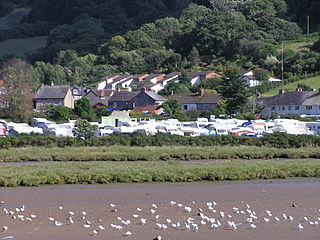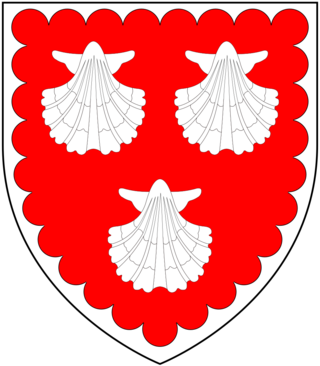Related Research Articles

The viol, viola da gamba, or informally gamba, is any one of a family of bowed, fretted, and stringed instruments with hollow wooden bodies and pegboxes where the tension on the strings can be increased or decreased to adjust the pitch of each of the strings. Frets on the viol are usually made of gut, tied on the fingerboard around the instrument's neck, to enable the performer to stop the strings more cleanly. Frets improve consistency of intonation and lend the stopped notes a tone that better matches the open strings. Viols first appeared in Spain and Italy in the mid-to-late 15th century, and were most popular in the Renaissance and Baroque (1600–1750) periods. Early ancestors include the Arabic rebab and the medieval European vielle, but later, more direct possible ancestors include the Venetian viole and the 15th- and 16th-century Spanish vihuela, a six-course plucked instrument tuned like a lute that looked like but was quite distinct from the four-course guitar.

John Taverner was an English composer and organist, regarded as one of the most important English composers of his era. He is best-known for Missa Gloria tibi Trinitas and The Western Wynde Mass, and Missa Corona Spinea is also often viewed as a masterwork.
John Sheppard was an English composer of the Renaissance.
Thomas Tomkins was a Welsh-born composer of the late Tudor and early Stuart period. In addition to being one of the prominent members of the English Madrigal School, he was a skilled composer of keyboard and consort music, and the last member of the English virginalist school.

Axmouth is a village, civil parish and former manor in the East Devon district of Devon, England, near the mouth of the River Axe. The village itself is about 1 mile (1.6 km) inland, on the east bank of the Axe estuary. The parish extends along the estuary to the sea, and a significant distance to the east. The village is near Seaton and Beer which are on the other side of the Axe estuary. According to the 2001 census the parish had a population of 493.
Robert White probably born in Holborn, a district of London, was an English composer whose liturgical music to Latin texts is considered particularly fine. His surviving works include a setting of verses from Lamentations, and instrumental music for viols.
Robert Parsons was an English composer of the Tudor period who was active during the reigns of King Edward VI, Queen Mary I and Queen Elizabeth I. He is noted for his compositions of church music.

Grimace was a French composer-poet in the ars nova style of late medieval music. Virtually nothing is known about Grimace's life other than speculative information based on the circumstances and content of his five surviving compositions of formes fixes; three ballades, a virelai and rondeau. His best known and most often performed work in modern-times is the virelai and proto-battaglia: A l’arme A l’arme.
Nicholas Ludford was an English composer of the Tudor period. He is known for his festal masses, which are preserved in two early-16th-century choirbooks, the Caius Choirbook at Caius College, Cambridge, and the Lambeth Choirbook at Lambeth Palace, London. His surviving antiphons, all incomplete, are copied in the Peterhouse Partbooks. Ludford is well-known as being the composer of the only surviving cycle of Lady Masses, small-scale settings of the Ordinary and Propers in three parts to be sung in the smaller chapels of religious institutions on each day of the week. Ludford's composing career, which appears to have ended in 1535, is seen as bridging the gap between the music of Robert Fayrfax and that of John Taverner (1495–1545). Music scholar David Skinner has called Ludford "one of the last unsung geniuses of Tudor polyphony". In his Oxford History of English Music, John Caldwell observes of Ludford's six-part Mass and Magnificat Benedicta that it "is more a matter of astonishment that such mastery should be displayed by a composer of whom virtually nothing was known until modern times".

Dr. Joshua F. Drake is a musicologist and hymnist and former faculty member at Grove City College in Grove City, Pennsylvania. His research, writing and presentations primarily analyze the structure of 15th century Latin Christian motets, which are a category of choral musical compositions. Drake is notable for his research and papers that challenge commonly held views regarding the complex and often misunderstood relationship between words and music in motets of the late 15th century, as well as his discoveries related to the origins of the Buonaparte family. He also served on the editorial advisory board for "The Quad" Magazine.
The 'Gyffard' Partbooks are an important set of English Renaissance choral partbooks, containing pieces by composers such as Thomas Tallis and John Sheppard, as well as additional unnamed composers, which are not found in other sources.
Blue Heron, directed by Scott Metcalfe, is a professional vocal ensemble based in the Boston area. The ensemble presents an annual concert series in Cambridge, Massachusetts, and performs throughout New England as well as touring the US; it made its European debut in the United Kingdom in 2017.
The Dow Partbooks are a collection of five partbooks compiled by Robert Dow in Oxford around 1581–88. The collection includes mostly choral but also some instrumental pieces. At the end is an instrumental La gamba and a canon, both a 3 and apparently copied from Vincenzo Ruffo's book printed in Milan in 1564.
The Glogauer Liederbuch is a Liederhandschrift of sacred and secular songs and instrumental music, written about 1480. It is the earliest surviving set of partbooks and an important source of 15th century musical material. The manuscript is named after the town of Glogau in Lower Silesia.

Drexel 4180–4185 is a set of six manuscript partbooks copied in Gloucester, England, containing primarily vocal music dating from approximately 1615-1625. Considered one of the most important sources for seventeenth century English secular song, the repertoire included represents a mixture of sacred and secular music, attesting to the partbooks' use for entertainment and pleasure, rather than exclusively for liturgical use.

Osbert Parsley was an English Renaissance composer and chorister. Few details of his life are known, but he evidently married in 1558, and lived for a period in the parish of St Saviour's Church, Norwich. A boy chorister at Norwich Cathedral, Parsley worked there throughout his musical career. He was first mentioned as a lay clerk, was appointed a "singing man" in c. 1534, and was probably the cathedral's unofficial organist for half a century. His career spanned the reigns of Henry VIII and all three of his children. After the Reformation of 1534, the lives of English church musicians changed according to the official policy of each monarch.
The Forrest-Heyther partbooks are a set of six manuscript partbooks copied in England in the sixteenth century. They are an important source of polyphonic Mass Ordinary settings by composers from the reign of Henry VIII, including John Taverner and Robert Fayrfax.

Bindon is a historic manor in the parish of Axmouth in Devon, England.

Walter Erle (c.1515/20-1581) of Colcombe in the parish of Colyton, of Bindon in the parish of Axmouth, both in Devon, and of Charborough in Dorset, England, was a courtier and servant of the Royal Household to two of the wives of King Henry VIII, namely Catherine Howard and Catherine Parr, and successively to his son King Edward VI (1547-1553) and two daughters, Queen Mary I (1553-1558) and Queen Elizabeth I (1558-1603) during their successive reigns.
The so-called Great Service is a set of canticles and other items for the Matins, Communion and Evensong services of the Anglican Church, composed by William Byrd. It is the last and most elaborate of his four services for the English liturgy. Byrd provides settings of seven items for the three principal rites of the liturgical day.
References
- ↑ Stanley Boorman, et al. "Sources, MS." Grove Music Online. Oxford Music Online. Oxford University Press, accessed February 5, 2016.
- 1 2 3 4 "The Peterhouse Partbooks – Peterhouse Chapel Choir". Srcf.ucam.org. Archived from the original on 2016-02-16. Retrieved 2016-02-05.
- ↑ "HOASM: The Peterhouse Partbooks". Hoasm.org. Retrieved 2016-02-11.
- 1 2 3 "HOASM: The Peterhouse Partbooks". Hoasm.org. Retrieved 2016-02-05.
- ↑ "Source Description". Digital Image Archive of Medieval Music. Retrieved 2016-02-05.
- ↑ "Source Description". Digital Image Archive of Medieval Music. Retrieved 2016-02-05.
- ↑ Sandon, Nicholas: The Henrician Partbooks Belonging to Peterhouse, Cambridge (Cambridge, University Library, Peterhouse Manuscripts 471–474): A Study, with Restorations of the Incomplete Compositions Contained In Them (PhD, University of Exeter, 1983)
- ↑ "Sandon | DIAMM". Digital Image Archive of Medieval Music. Archived from the original on 2016-02-29. Retrieved 2016-02-05.
- ↑ "WGBH Media Player Classical Connections: Peterhouse Partbooks". Wgbh.org. Retrieved 2016-02-05.
- ↑ "Antico Edition Music from the Peterhouse partbooks". Anticoedition.co.uk. Retrieved 2016-02-05.
- ↑ "The Peterhouse partbooks". Blue Heron. 2013-08-06. Retrieved 2016-02-11.
- ↑ Sandon, Nicholas. "Our Lady: Music from the Peterhouse Partbooks". Scribe Music. Retrieved 2016-02-05.